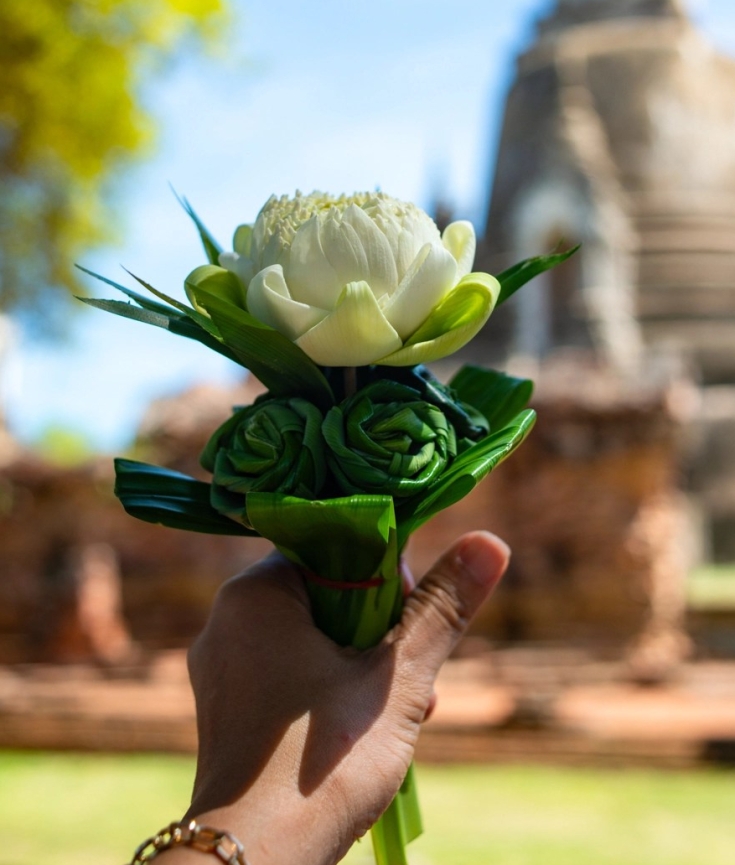During a brief stopover in Thailand, I took the opportunity to observe the flower culture and its relationship with mindfulness.
I love to see the flower offerings at every corner of the city of Bangkok. It reminds me a lot of Bali. Flowers are also a part of Thailand’s famous spa and wellness tradition.


As a flower artist who’s studying ikebana, I feel that it’s important for me to see how the flowers were prepared for the city’s widespread altar offerings. So, I made a trip to Pak Khlong Talat, Bangkok’s biggest wholesale and retail flower market situated close to the Chao Phraya River.
Bangkok’s biggest flower market
The market was already busy at mid-morning. It was blistering hot, so I’m not sure how the flowers stayed fresh and upright for so long. Maybe tropical flowers are made differently than temperate-climate flowers.
This made me appreciate the fact that the Thai’s put extra effort to have fresh flowers in their daily lives. I feel a huge respect for those practising ikebana and fresh flower arrangements in hot countries.


“The market was already busy at mid-morning. It was blistering hot, so I’m not sure how the flowers stayed fresh and upright for so long.”


The flower vendors were kind and accommodating when I asked for photos. They were pretty shy, so I did my work quickly. There were plenty of male workers preparing the flowers for sale. Evidence that floriculture isn’t an exclusively feminine activity.
I also booked a guided tour to Thailand’s historical city, Ayutthaya, to see the elegant temple complex and how the flowers are presented there. I wanted to see the actual environment where the flowers complemented a special sacred space. I wasn’t disappointed.
We set out for our 6.30am hotel pick-up. We arrived at Ayutthaya temple complex shortly after 9am. There I got a clearer idea of the temple’s garden landscape and how the flower offerings were positioned around a Buddhist temple complex.



Trees at the temples
In a typical Southeast Asian style, there is always a frangipani tree near a holistic spot. White flowers are considered to have a powerful healing property in this region.
Some of the temple ruins have ancient bodhi trees growing into the bricks, intertwining with the old Buddha statues. The Bo tree is considered sacred in Buddhism because it was where Siddharta Gautama first attained enlightenment.


“I wanted to see the actual environment where the flowers complemented a special sacred space. I wasn’t disappointed.”


At Wat Mahatat, my favourite temple on Ayutthaya Island, I saw a sprawling lotus pond next to an elephant training school. Our tour guide, Eddie, gifted me a bouquet of white lotus and fragrant pandan leaves to present at the altar. The creamy petals were delicately folded. It was a serene and beautiful experience.
At the final temple we visited, Wat Lokayasutharam, a handsome flame tree (royal poinciana) covered with red blooms stood proudly in front of the giant Reclining Buddha. It fits the Lotus Sutra description of a heavenly realm where “mandarava blossoms rain down, scattering over the Buddha and the great assembly.”



Flowers and wellness tradition
Flowers are the universal symbol of beauty. The purpose of decorative flowers is to amplify a positive message and express tender feelings. They add a calming and healing effect to a space.
Flowers have been an important component of wellness practice and traditional medicines for centuries in Southeast Asia. It’s great to see the custom still practised every day in Thailand.
I’ve been to Bangkok several times for work and as a tourist in the past. This time, I’m glad to discover Thailand through the eyes of a flower artist. It’s a spiritual country, rounded by the softness of altar flowers and impeccable hospitality.


We took a Bigcountry Vacation tour to Ayutthaya from Bangkok. We travelled with our low impact Design Shop backpacks.
“The purpose of decorative flowers is to amplify a positive message and express tender feelings.”


